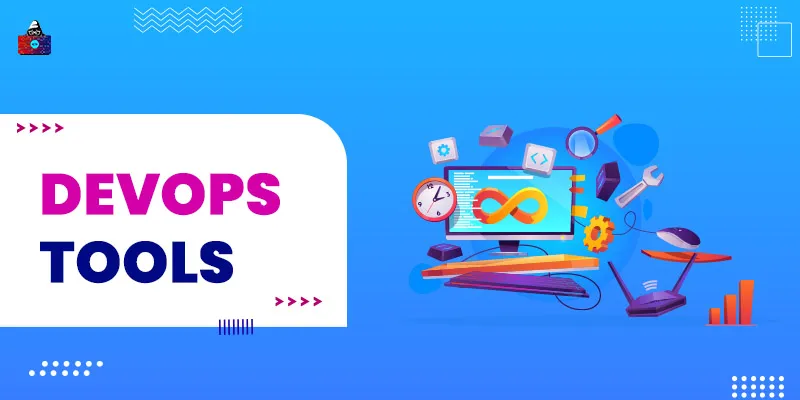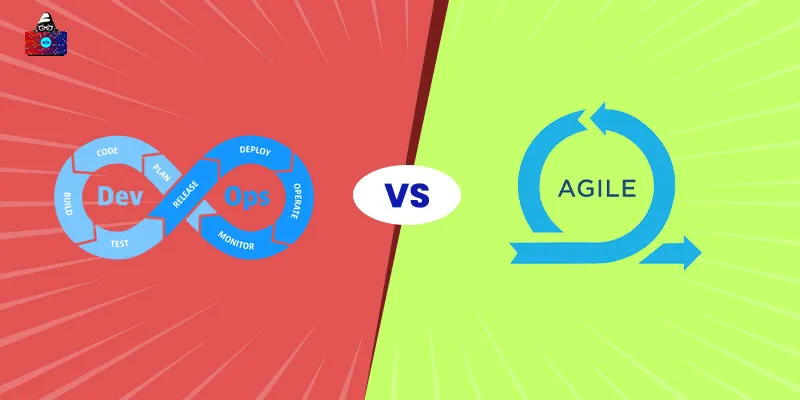In the past few years, DevOps usage has been growing tremendously and is expected to soar further. According to a report by Puppet , for organizations and individuals that adopt DevOps more quickly, change management becomes a lot more effective (as high as 65%). However, one of the top challenges that engineers and developers face while adopting DevOps is consolidating tools and software and the setup of operational engineering units.
In this article, we will discuss some of the top trending tools that are easy to adopt and highly effective when it comes to change management. These tools are easy-to-setup, can accommodate high levels of scalability and flexibility, and provide a range of features and accessories for the end-to-end development process. Before jumping into the top DevOps tools, you must understand the true meaning of DevOps.
What does DevOps mean?
If you think of DevOps as a tool, then sorry to say, but you are very, very wrong. DevOps is not a software or a tool that you can adopt and use for development practices, and it's a culture or a practice that you can adopt to ensure that you go through continuous development by providing a platform for operations and development teams to work together. It's a mixture of tools, paradigms, and practices that will allow you to soar up your organization's output by inculcating CI/CD practices among your teams. It bridges the gaps between IT operations teams and software Teams. It promotes four important goals, namely - Sharing, Automation, Culture, and Measurement.
Future of DevOps
Here's a string of useful insights by Veritis:
- By 2018, around 50% of all the organizations have already adopted or implemented DevOps.
- The deployment frequency of the companies/organizations/teams that have adopted DevOps has increased up to 200 times compared to those that haven't adopted it yet.
- With the adoption of DevOps practices, the time allotted for rework or unplanned work has decreased by 22%.
- The recovery from failures has become 24 times faster due to DevOps adoption, and it has also minimized downtime.
- The forecast for 2017-2023 for the DevOps market globally is a whopping USD 9.41 billion and a CAGR rate of up to 18.7%.
These figures and estimations are quite astonishing and paint a precise understanding of the prospect of DevOps. Hence, having as many DevOps tools in your portfolio as possible will take you to create a portfolio that will be hard to ignore by any recruiter.
Best DevOps Practices
The effectiveness of selecting DevOps is determined by the practices you adopt while using the tools and software that enhance Continuous Integration. It's very important to define good rulesets, ownership, and usability with the help of a bunch of practices. Some of the best DevOps practices that you must adhere to to reap the maximum benefits it are -
Service Portfolio
There are tons of available tools that provide you with a range of benefits, and each of these tools has several cheap alternatives. However, when deciding the right tool that aligns perfectly with your requirements, you must mark the boundaries. Before taking up any tool and deciding whether it is the right one, you should have a clear and satisfying answer to the following questions -
- Where are these tools and software stored?
- Are there any standard sets of practices, and if yes, are they feasible to adopt for your organization?
- Who has access to these tools?
Creating and maintaining a centralized repository or hub for all these tools will prove helpful as it will teach transparency and clarity. This is the essence of adopting DevOps as it allows you to share tools and responsibilities across teams.
Automate your Testing Process
In agile development, in-sprint testing is essential. Testing should be continuous, less time-consuming, generate a comprehensive overview, pinpoint bugs, and report them to the appropriate person. Applications that are being developed today have complex requirements and hence, require thorough testing. Now, most of the test cases are repetitive, and performing tests on such repetitive test cases, again and again, can be a hectic process and consume lots of resources. Moreover, DevOps tools integrate quite well with automated testing tools. While selecting the right tool for your DevOps processes, you must select such tools to integrate with popular automated testing tools. The reason is that even though your application right now might be small and have fewer requirements, after a point of time, when you start getting traction, you will ultimately have to switch over to automation to save up time and resources.
Adopt Continuous Deployment
This is the essence of agile development. Instead of deploying the entire piece of code at the very end of the development process, you can start deploying small chunks of codes or modules on-the-go, once they have been passed by the QA team and have gone through thorough testing. The major advantage is that it removes manual hassles since there are tons of tools that do the same job for you. It's quite clear that automating testing and deploying chunks of code is the ultimate goal to ensure modern development practices, and this is what DevOps stresses.
Top 10 DevOps Tools to learn
There are tons of tools and software used by thousands of companies and organizations to streamline and optimize processes to generate better outcomes. However, according to experts, these are the top 10 tools that help businesses and organizations to transit their operations to DevOps or improve the existing DevOps practices.
1. Jenkins
Jenkins is a CI (Continuous Integration) server and is quite popularly used for performing tests and reporting in real-time. It monitors the execution of repetitive tasks. It helps developers and operations teams to integrate changes in the project very quickly and efficiently. It has a pipeline feature that quickly and automatically transfers chunks of codes into the central/shared repositories, performs testing, and even generates comprehensive reports. It can be used for various purposes such as a pipeline for the trio of "develop-test-deploy", creating triggered events, and automating repeated and scheduled tasks. Moreover, it has excellent API support, which allows you to carry out easy and quick integrations with other popular tools.
Features of Jenkins
- It's free since it's open source.
- It's highly customizable and designed for scalability.
- It's easy to install and requires little maintenance.
- It allows you to create a pipeline with multiple build jobs to distribute tasks.
- It has 1000s of plugins that support your testing and development process.
- It's java-based and hence, platform-independent.
- It has an intuitive web interface that allows easy updates.
2. Docker
Docker is a container-management tool that allows developers to create and manage applications inside packaged environments called Containers. Regardless of the infrastructure, developers can easily create containers, install libraries and packages that the application requires, start building their applications, share it among other developers, and deploy the application all within the same container environment. The containers are isolated from one another, and hence, it allows developers to run multiple containers in the same machine. You can create a multi-container application and allow communication between the multiple containers to share information and resources, or you can create a network of container clusters with the help of Docker Swarm. It allows all the important tools such as a network interface, storage, security, etc. The extensive range of benefits that DockerDocker provides to developers has made it quite popular among the developer community. You can now easily develop, manage, and deploy applications with simple commands, scale them to several nodes, share them and run them on any machine without having to worry about dependency-conflicts.
Features of Docker
- You can create containers and isolate apps within the containers to enhance security.
- You can create Docker images which are the applications' blueprints; incorporate changes by mentioning them in the docker file and rebuild the image.
- You have private and public registries to maintain images and access thousands of popular images such as Ubuntu, SQL, NodeJs, etc.
- You can easily scale your application to even more than 1000 nodes and perform updates with near-to-zero downtime.
- It allows you easy portability, scalability, and isolation.
3. Ansible
Ansible is one of the leading tools used by the DevOps community to automate an application's entire lifecycle. When tools like Puppet, Chef, etc., started addressing the complexities associated with automating the infrastructure of highly-scaled applications, Ansible was born. Ansible is open-source, meaning it's free to use. This helps teams to scale up quickly and efficiently, thus ensuring productivity. It specializes in application deployment, provisioning of software, delegating the infrastructure as chunks of code, and managing the configuration. It has a very simple build but is quite powerful as well.
Features of Ansible
- It's easy to operate and set up.
- It's free since it is open-source.
- Allows you to automate cloud deployments, network configurations, and management, and development environments.
- You don't need an agent to maintain Ansible.
- You can automate those tasks or operations that are repetitive.
- It uses YAML format, so it's human-readable.
- The application is written in Python and hence a very slick, modern UI.
- It has a very low learning curve which means that you can learn it within a few hours.
4. Puppet
Puppet mainly specializes in configuration management , automation, and centralization. It's open-source and used to automate delivery, inspection, and monitoring software applications throughout the lifecycle. It allows you to create an actionable, intelligent, and scalable code infrastructure by defining host-specific configurations and runs frequent checks to ensure robustness. Before the introduction of Containers, it was quite often used with Jenkins and other frameworks in pipelines. Since it gives complete access to the users across all machines, applying changes across these machines becomes easier, and hence you can scale dynamically.
Features of Puppet
- It eliminates manual work and manages, models the entire environment.
- It's open-source, provides intelligent orchestration.
- It creates a healthier environment by evenly distributing work among teams and has extensive documentation for support.
- It has the much-needed feature of real-time reporting.
- It has a modular design, easy-to-understand, and an intuitive UI.
5. Kubernetes
Kubernetes is an open-source tool that is widely used with container management platforms such as DockerDocker. It's a container-orchestration tool that has the revolutionary ability to scale, manage, and automate deployments. Suppose you have an application that has been deployed on three container servers or nodes. Now, you have started getting traction, and your servers cannot take up the load. You want to scale them up to 50 servers. Kubernetes helps you decide which node should be a part of which cluster and provides an easy way to monitor all these clusters. You can use Kubernetes to automate scheduling processes, deploying multi-container applications, and scale them. It has a modular architecture with components such as control planes, nodes, and pods. All these components work together to create a perfect blend of container orchestration software.
Features of Kubernetes
- Maintaining multiple clusters of containers and communication between them becomes very easy.
- It becomes quite easy to port the containers, maintain and assign user privileges, etc.
- It introduces stability to the overall network of clusters.
- It allows easy adaptability to new environments and enhances productivity.
6. QuerySurge
QuerySurge is one of the top DevOps tools as it is a smart data testing tool that can automate the data testing of Data Warehouses, Big Data Business Intelligence Reports, and so on. It's a first-of-its-kind tool that provides an intelligent testing solution by automating data testing and validation. It automatically executes test cases triggered by events/processes, providing immediate results all during the pipeline workflow. Its API features allow you to develop or modify connections with stores of data, flow controls, test queries, etc.
Features of QuerySurge
- Detect issues in your data continuously in the delivery pipeline.
- Increase coverage of data.
- Use analytics for optimization and improve ROI.
- Choose a CLI or Rest API.
- Generate, update, executes test cases using 60+ API calls.
- Integrate with all popular DevOps tools.
7. Chef
Chef is a cloud-based DevOps automation tool that allows you to carry out complex and repetitive tasks by automating them. It is a powerful tool that creates code from infrastructure, and it doesn't matter whether you are working on cloud, host machines, or hybrid environments. It automates the deployment, configuration, and management of the entire network. The Chef infrastructure recipe allows you to get hold of resources such as templates, packages, etc., allowing you to describe the infrastructure, and the chef workstation includes tons of tools that will help you to interact with the chef infra. You can upload your code to the infrastructure, create and configure nodes using the Chef client.
Features of Chef
- Application delivery by providing your team with the capability to develop, deploy, and run applications/software on multiple environments. It helps you define your infrastructure-independent coding structure and allows features such as dependency management, health checks, update rolls, etc.
- At the same time, infrastructure ensures that the configuration policies are testable, flexible, readable, and versionable.
- Observability by making sure that the policies and dependencies are easily verifiable.
- Security by allowing you to describe your compliance and security rules as code in a consistent fashion.
8. Basis Technologies
Basis Technologies is engineered specifically for those who have adopted the SAP tool for development. They offer them a test automation platform and allow them to transform a fixed-release-cycle model to a completely different on-demand-delivery model that perfectly aligns with CI/CD, DevOps practices. They have a tool called ActiveControl, which allows you to adopt agile practices by automating releases with fast and reliable methodologies, gaining control and quality, and managing a multi-development system dynamically. They allow you to eliminate the need for spreadsheets, perform change-delivery frequently and efficiently, providing complete control and governance. This allows your SAP teams to carry out business goals with reduced costs and risks.
Features of Basis Technologies
- Completely customize the approval process.
- Automate manual processes such as build, dependency or conflict management, and deployment.
- Integrate SAP in CI/CD pipelines using popular tools such as Jenkins, etc.
- Perform shift quality left with the help of tons of automatic analyzers.
9. Embold
Embold is a tool that lets you fix bugs the modern way. It's an analytics tool that analyses static code and flags issues, telling you the exact place to start fixing bugs. You can leverage detailed visualizations to unveil the issues that are usually hard-to-detect. You can find out design issues that usually hinder you when you try to maintain code. This tool readily integrates with your workflow and other DevOps tools to make your lives easier.
Features of Embold
- It detects up to 30 anti-patterns and avoids error-prone practices and solutions.
- It identifies problematic snippets in your code, telling you how it affects your entire code so that you can easily debug your code up to 40 times faster.
- It has a massive array of metrics and a knowledge base that helps you identify issues, visualize them and explain them.
- It integrates easily with popular DevOps tools such as Jenkins, Gitlabs, Azure, etc., and has 1000s of plugins.
10. Prometheus
Prometheus is an open-source tool that is widely used across popular companies to monitor their services. It supports a variety of languages to power your metrics and creates alerts with modern solutions. It has a flexible language to create queries to create visualizations, plays around time-series data to provide top-notch insights, and has custom libraries. It has precise alerting managers, several client libraries and supports tons of third-party integrations. Prometheus's features make it one of the best tools for monitoring services on a large scale.
Features of Prometheus
- It implements a highly dimensional data model that can identify time-series data with key-value pairs and metrics.
- It allows the slicing of time-series data with the help of PromQL.
- It offers multiple modes to create useful visualizations.
- It stores the data on a local disk and allows scaling through sharding.
The Trend
If we look at the popularity of the top 5 DevOps tools that we have mentioned in this article, we will find that in the past year, DockerDocker has grabbed the top place in terms of the most searched tools among the ones mentioned and rightly sits on top of the deck. The next popular tool is Kubernetes and is followed by Jenkins, Ansible, and Puppet.
Takeaways
You are lucky that you have lots of tools to choose from when adopting DevOps for your organization. From development to testing and deployment, some tools automate the processes and help you monitor and address all the uses. DevOps means that both the development and IT Operations teams come together to work and create a healthier working environment. With better communication, properly divided work, and enhanced productivity, the delivery of software becomes quite faster. It's very important to choose the right tool, play around with it, and tailor the company workflow. We certainly hope that this guide will give you a clear direction and allow you to select the right DevOps tool to get you started with DevOps or improve the existing practices.
People are also reading:





Leave a Comment on this Post